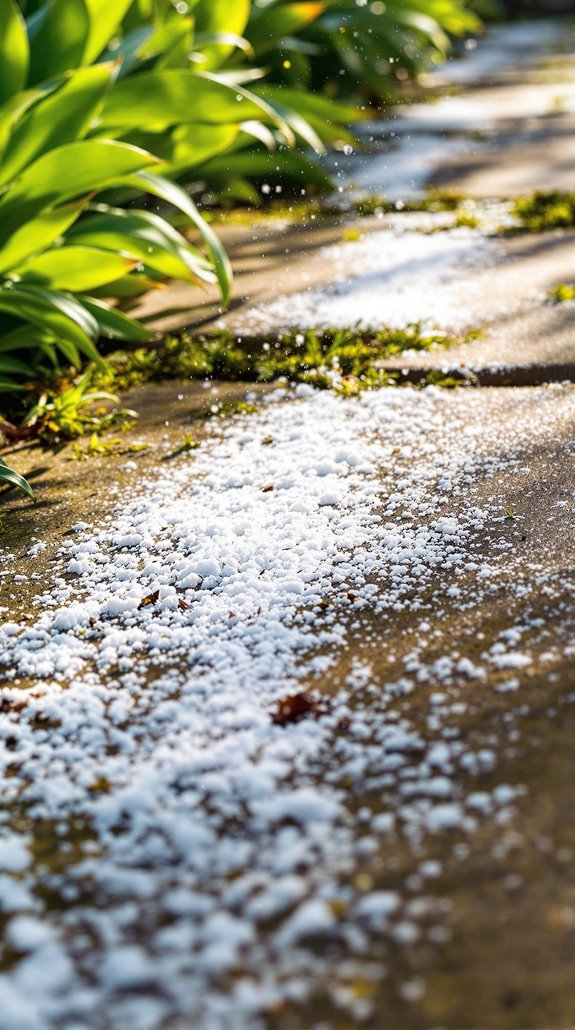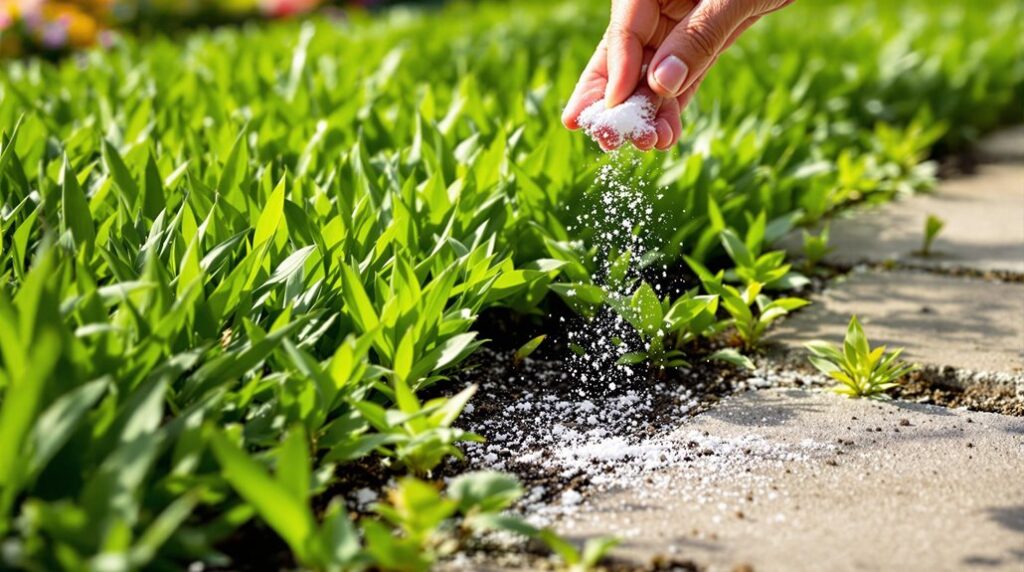I’ve tested baking soda against weeds in my own garden, and I’ll tell you straight away—it works, but not how you’d expect. While it’s true that sodium bicarbonate can damage plant tissues through osmotic disruption, the reality is far more nuanced than most garden hack articles suggest. The effectiveness depends heavily on timing, application method, and the specific weeds you’re targeting. Before you raid your kitchen cupboard, there’s something essential you need to understand about its limitations.
Key Takeaways
- Baking soda kills weeds through osmotic disruption, dehydrating plant tissues and creating cellular water imbalance for rapid desiccation.
- Mix one tablespoon per litre of water and spray thoroughly, or apply dry baking soda to dampened small weeds.
- Most effective on young, shallow-rooted weeds under 5cm; mature and deep-rooted perennials often survive treatment attempts.
- Apply during sunny, dry days above 18°C with no rain forecast for 24 hours for optimal effectiveness.
- Use physical barriers around desirable plants and water them deeply beforehand to prevent accidental sodium damage.
How Baking Soda Works as a Natural Weed Killer
Baking soda kills weeds through osmotic disruption—it dehydrates plant tissues by drawing water from cells when applied directly to foliage. The sodium bicarbonate creates cellular water imbalance, causing rapid desiccation of leaves and stems. Its alkaline properties literally burn plant surfaces on contact, accelerating the damage.
I’ve found that sunny conditions dramatically improve effectiveness. The heat speeds evaporation and helps residue formation stick to weed surfaces. However, you’ll notice this method works best on young, shallow-rooted weeds. Mature plants with established root systems often survive because baking soda primarily acts at surface level.
The salinity also accumulates in soil, inhibiting water absorption through roots. This starves weeds but means you need strategic application to avoid harming nearby plants you want to keep. You can expect to see visible effects within 24-48 hours of application, though complete weed death may take several days to weeks depending on the plant type and conditions.
Best Application Methods for Maximum Effectiveness
While baking soda’s effectiveness depends heavily on proper application, the method you choose determines whether you’ll achieve quick results or waste your effort.
For small weeds under 5cm, I apply dry baking soda generously to dampened leaves and stems, leaving it undisturbed for 24 hours. This direct approach works brilliantly on driveways and patios.
For larger areas, I mix 1 tablespoon per litre of water and spray thoroughly during sunny conditions, reapplying every 3-4 days.
My most powerful technique combines both: I sprinkle dry baking soda first, then spray 20%+ acetic acid vinegar directly onto tough broadleaf weeds. The fizzing reaction breaks down cell walls rapidly. Remember that baking soda can harm other plants in the vicinity, so precise application is crucial.
I always target midday applications when temperatures exceed 18°C and guarantee 8 hours of sun exposure for peak dehydration.
Understanding the Limitations and What Weeds It Won’t Kill
Despite its usefulness in specific situations, baking soda won’t tackle every weed problem you encounter. I’ve learned it’s completely ineffective against deep-rooted perennials like bindweed, thistle, and Japanese knotweed—their extensive root systems simply regenerate after surface damage. You’ll also struggle with grassy weeds like crabgrass and quackgrass, which resist the desiccating action through their waxy cuticles.
Large, established weeds with woody stems, including mature ivy and brambles, won’t succumb to baking soda treatment. The sodium only burns visible foliage while roots remain unharmed, causing rapid regrowth within weeks. For these stubborn weeds, multiple applications or combined methods may be necessary. Succulent weeds like purslane retain too much moisture for effective treatment.
Safety Precautions to Protect Your Garden Plants
Although baking soda can effectively eliminate certain weeds, you’ll need to take serious precautions to protect your garden plants from its harmful effects. I recommend applying physical barriers like cardboard or plastic sheeting around desirable plants before treatment. You should water your non-target plants deeply beforehand to dilute potential sodium exposure.
Use targeted dispensing methods such as spray bottles or brushes rather than broad applications. Apply treatments only during calm, dry weather to minimize drift. If you accidentally contact non-weeds, immediately rinse them with fresh water.
Keep applications restricted to isolated areas like driveways and walkways. Use low-concentration solutions with a 1:1 baking soda-to-water ratio, applying only to weed foliage while avoiding soil drenching that contaminates root zones. Remember that salt buildup from repeated applications can damage nearby plants even when you’re careful with initial treatment.
Expert Tips for Optimising Your Baking Soda Weed Treatment

Now that you’ve learned how to protect your garden plants, let’s focus on maximizing the effectiveness of your baking soda applications.
I’ve found timing makes all the difference. Apply on sunny, dry days when rain isn’t forecast for 24 hours – you don’t want your solution washed away before it works.
For concentration, I start with one tablespoon per liter of water for small weeds, but I’ll increase this for larger, established ones. Remember, baking soda primarily affects the leaves through dehydration, so it won’t destroy deep root systems on mature weeds.
Target young, tender weeds for best results. They’re most vulnerable to the salt’s desiccating action. For weeds in pavement cracks, I sometimes apply dry baking soda directly – it’s particularly effective in these confined spaces. Consider using it along driveways where precision application prevents damage to nearby lawn areas.
Conclusion
I’ve shown you that baking soda’s an effective, natural weed killer when you apply it correctly. You’ll get best results targeting young weeds on sunny days using the 1:1000 ratio I’ve outlined. Remember, it won’t work on established perennials, and you must protect your desirable plants during application. Follow my timing and concentration guidelines, and you’ll achieve reliable weed control without harsh chemicals. It’s a proven method that’ll serve your garden maintenance needs well.
References
- https://www.idealhome.co.uk/garden/garden-advice/does-baking-soda-kill-weeds
- https://www.thespruce.com/baking-soda-weed-killer-11734924
- https://www.jennychem.com/blogs/news/does-bicarbonate-of-soda-kill-weeds
- https://www.gardeningknowhow.com/garden-how-to/info/does-baking-soda-kill-weeds
- https://www.gardenbenches.com/blog/homemade-weed-killer/
- https://www.realsimple.com/does-baking-soda-kill-weeds-11717457
- https://www.almanac.com/baking-soda-weed-killer-tips-and-tricks-homemade-solution
- https://www.homesandgardens.com/gardens/does-baking-soda-kill-weeds
- https://www.apartmenttherapy.com/does-baking-soda-kill-weeds-37407984
- https://www.southernliving.com/how-to-use-baking-soda-in-your-garden-11736261

